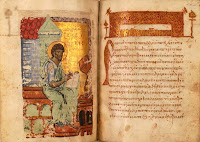For previous entries, just click on the Bible and Other Faiths label at the end of this post.
Peoples surrounding Israel, and their godsThis chapter’s a short one, offering a quick overview of some features of the Old Testament world. As the time period which the OT covers is a long one, belief systems and practices obviously change and develop throughout. Nonetheless, we can still establish some basic characteristics of these surrounding religions.
- People believed in many gods. They might have a main god, but there would usually be other minor gods as well, ruling over various aspects of life. Society was pluralist.
- Gods were associated with particular peoples and places. Religions were territorial and/or national.
- The king had a special relationship to the god. He represented people to the god and vice versa, and so sometimes is seen as divine himself. Religion thus had a political character.
- Gods were sometimes merged. Sometimes, it was difficult to tell gods apart from their names. Other times, a conquered people meant a conquered god. Religions were syncretistic.
- Gods had particular functions. There was a god of war, a god of childbirth and so on; at times they formed a hierarchy based on their importance to everyday life.
- Gods often expressed something in the natural world. Baal, for instance, had control over the rain.
- There were stories about the gods. “The peoples explained their world by telling these stories, usually vivid poetic descriptions of battles and sexual exploits”. Many of them also had creation stories.
- Gods were worshipped in similar ways. They took different forms, were often represented by images, had priests and temples, and sacrifices were commonly offered to them. There were also various rites, some of which acted out the stories of the gods, including their sexual exploits. This led to the rise of cult prostitution.
- There were religious experts. Perhaps a priest, or a storyteller, or a seer.
IG moves on the people groups of the time, who come from 3 main areas. Firstly, there was Mesopotamia, the fertile land between the Tigris and Euphrates, where Abraham came from and where the Israelites were exiled to. Its people included the Sumerians, whose creation myth included human failure and a great flood. “Sumerian society was organised mainly in villages grouped around cities to form city states, each of which would have a ruling council under a king who was a representative of the city’s chief god”. Then there are the Babylonians. Babylon was a centre of power for much of its history – good (very) old Hammurabi, for instance, was one of its rulers, who attempted to unite the whole of Mesopotamia. One of their gods, Marduk (also Bel), was considered particularly powerful and is mentioned in Isaiah 46:1 and Jeremiah 50:2. Then there are the Assyrians, north of Babylonia. They were a major political force until the rise of the Babylonians. Their goddess of love and war, Ishtar, had her temple in Niveneh.
Secondly, there is Egypt, which was a very different civilization, with the River Nile serving as the basis of its economy. Egypt regularly interacted with peoples in Canaan throughout biblical history, and many Semites (Hebrews) came to live among the Egyptians at different times. They had lots of interesting gods [I did a project on Egypt when I was about 12 or 13 and it was fun finding out about all about them!], most prominent being the sun [god]. Egyptian worship is rather different from Mesopotamia. Their temples were isolationist, with only priests allowed entry, and gods brought out only for special occasions.
Finally, there is Canaan, the "Promised Land". There was an interesting variety of people groups there, including Amorites, Moabites, Edomites, Phoenicians and Philistines. Most of what we know about them comes from texts discovered in the ancient city of Ugarit, now part of modern-day Syria. El is the chief god, worshipped under different names – some speculate that Melchizedek was priest of El-Elyon, usually translated “God Most High” (Gen. 14:18). El is Creator, kind, merciful, wise. Under him is a pantheon of gods, sometimes called “sons of El”. The Canaanite god Christians are most familiar with is Baal, meaning “master”. He’s the weather god, meaning that if you want a good harvest you’re best be not displeasing him! Interestingly, there’s a Canaanite story where Mot, the god of death, kills Baal, who in turn gets killed by Anath, Baal’s consort, who revives Baal, has sex with him and therefore restores his powers. This story reflects the pattern of rainfall and fertility in Canaan – Baal’s death corresponding with the dry period and so on. The story was acted out with temple prostitutes to ensure Baal’s “revival”.
Throughout this book, IG will throw out reflection questions from time to time for us to think about, and she tosses up one here:
In what ways are the religions in your area like the religions of these different nations?My gut feeling is that many of my Malaysian/Majority World readers will have no problem finding points of similarity. Off the top of my head I immediately think of the Dayaks and
Gawai, or harvest festival, with various ceremonies performed to ward off evil spirits and offering rites of thanksgiving to gods of the natural world.
This chapter provides us with bite-sized chunks of information for orientation purposes, as many of us will have very little idea of the OT cultural-historical background. It’s almost too short, but since she’s writing
The Bible and Other Faiths and not
Encyclopaedia of the Ancient Near East, it’d be churlish to quibble.
Next chapter and into the Bible itself
Beginnings: Genesis † Expand postLabels: books, The Bible and Other Faiths
















